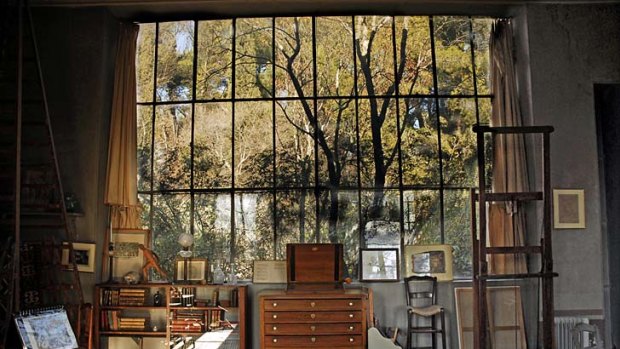
Petits bijoux ... Cezanne's workshop.Credit: AFP
Annabel Simms nominates small but perfectly formed museums beyond Paris.
One of the delights of visiting France is having the time to visit its small museums, often established in the homes of artists, authors - even chefs - who lived in the surrounding area or sometimes in the museums themselves.
Here are 10 of the best outside Paris. Remember, many French museums are closed on Tuesdays and, naturellement, for lunch.
Musee de l'Hospice Comtesse, Lille
Step into the peaceful 16th-century Flemish interior of a charitable hospice founded by the Comtesse Jeanne de Flandre in 1236, behind the shopfronts of Lille's oldest street. The public ward, pharmacy, kitchen, refectory, chapel and the nuns' dormitory mainly date from the 17th and 18th centuries. The rich social and cultural history of Lille is evoked by period furnishings and paintings.
32 Rue de la Monnaie; see mairie-lille.fr.
Maison de Jules Verne, Amiens
You can see the annotated map that Jules Verne used while writing Around the World in 80 Days in the house where he lived and worked from 1882 to 1900. The nine rooms include the study where he wrote Twenty Thousand Leagues Under the Sea and the attic where models of the flying machines imagined in his books are displayed.
2 Rue Charles Dubois; see amiens.fr.
Musee Flaubert et D'Histoire de la Medecine, Rouen
The quiet 18th-century house in which Gustave Flaubert was born in 1821 was the official residence of the surgeon at the local hospital - his father, Achille-Cleophas Flaubert. So it is also a museum of the history of medicine in Rouen from the 12th to the 20th century, and is well worth a visit for its scientific as well as its literary interest. It has a unique model of a woman giving birth and, of course, Flaubert's famous parrot.
51 Rue Lecat; see haute-normandie.fr.
Musee de la Prehistoire D'Ile de France, Nemours
This is a most unusual presentation of prehistory, using a specially designed glass-and-cement building in the middle of a rocky, forested site to give visitors the illusion of actually sharing their ancestors' environment - without the discomforts. The building is listed as an outstanding example of modern architecture and the rich collection is cleverly displayed to appeal to adults and children.
48 Avenue Etienne Dailly; see tourisme77.fr.
Triptyque du Maitre de Moulins, Moulins
Don't miss a 20-minute guided visit to the masterpiece by an unknown artist displayed in the cathedral: a triptych commissioned by the Duke of Burgundy circa 1500, showing himself, his wife and their daughter kneeling on either side of the Virgin and Child. The painting is kept in a darkened room, lit only when the panels are opened for visitors, and the effect is magical. The commentary (in English on request) explains how the painting prefigures the Renaissance, with the Duke and his family shown the same size as the Virgin, among other revealing details.
Cathedrale de Moulins, Place des Vosges; see www.moulins-tourisme.com.
Atelier Cezanne, Aix-en-Provence
Paul Cezanne designed this studio, situated on land he acquired on a hillside just outside his native Aix, in 1901, and worked in it until his death in 1906. Surrounded by light, silence and his favourite objects, which are still in place, it was here that he painted the world-famous still lifes of his final period. There is a garden tearoom and shop.
9 Avenue Paul-Cezanne; see atelier-cezanne.com.
Villa Kerylos, Beaulieu-sur-Mer
The visit to this replica of a classical Greek villa overlooking the Mediterranean and Cap Ferrat, completed in 1908 for the archaeologist Theodore Reinach, ought to be an entirely kitsch experience. It was built around a peristyle, richly decorated with mosaics, marble and frescoes - even the beds were copied from ancient models. But it really does evoke the spirit of ancient Greece, especially the gallery of life-size classical statues at sea level, outlined against the backdrop of the Mediterranean.
Impasse Gustave Eiffel; see www.villa-kerylos.com.
Musee Escoffier de L'Art Culinaire, Villeneuve-Loubet
Located in the house in which the father of modern cuisine, August Escoffier, was born, this excellent little museum is aimed principally at cooks and foodies but children will also find the imaginative room sets fascinating. Audio-visual presentations take place in the tiny cellar and there's a menu room featuring some amazingly elaborate early 19th-century menus.
3 Rue Auguste Escoffier; see fondation-escoffier.org.
Chapelle du Rosaire, Vence
Henri Matisse spent four years working on every aspect of this beautiful Dominican chapel, from the murals and the candle holders to the bronze crucifix on the altar and the priests' vestments. Not surprisingly, he considered the Chapelle du Rosaire, with its white floor and ceiling and yellow, green and blue windows, to be his chef-d'oeuvre. Though it's not a gallery as such, it's a wonderful and moving way to view Matisse's work. Buy a postcard or two in the gift shop - all proceeds go to support the Dominican nuns and the chapel itself.
466 avenue Henri Matisse; see ville-vence.fr.
Musee Jean Cocteau, Menton
The painter and poet Jean Cocteau was a regular visitor to Menton in the late 1950s. He painted the town's Salle des Mariages as well as a mural for the mayor's office before designing the restoration of a small 17th-century fort in the Old Port. It's this bastion that now houses the charming Musee Jean Cocteau, with its pebble mosaics, tapestries, pastels and ceramics. You can also visit the Wedding Room in the Town Hall, Place Ardoino, for a couple of euros.
Vieux Port; see tourisme-menton.fr.
- Telegraph, London
Sign up for the Traveller Deals newsletter
Get exclusive travel deals delivered straight to your inbox. Sign up now.